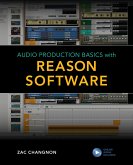Richard James Burgess (Director of Marketing and Director of Sales
History of Music Production
Richard James Burgess (Director of Marketing and Director of Sales
History of Music Production
- Broschiertes Buch
- Merkliste
- Auf die Merkliste
- Bewerten Bewerten
- Teilen
- Produkt teilen
- Produkterinnerung
- Produkterinnerung
The History of Music Production offers an authoritative, concise, and accessible overview of nearly 140 years of production of recorded music. It describes what role the music producer has played in shaping the creation, perception, propagation, business, and use of music, and discusses the future of the music production industry.
Andere Kunden interessierten sich auch für
![The Secrets of Dance Music Production The Secrets of Dance Music Production]() David FeltonThe Secrets of Dance Music Production44,99 €
David FeltonThe Secrets of Dance Music Production44,99 €![Music Production Music Production]() Michael ZagerMusic Production148,99 €
Michael ZagerMusic Production148,99 €![Music Production Music Production]() Michael ZagerMusic Production73,99 €
Michael ZagerMusic Production73,99 €![The Art of Record Production The Art of Record Production]() The Art of Record Production68,99 €
The Art of Record Production68,99 €![Music Production & DJing for EDM Music Production & DJing for EDM]() Tommy SwindaliMusic Production & DJing for EDM18,99 €
Tommy SwindaliMusic Production & DJing for EDM18,99 €![Music Production Music Production]() Carlos LellisMusic Production94,99 €
Carlos LellisMusic Production94,99 €![Audio Production Basics with Reason Software Audio Production Basics with Reason Software]() Zac ChagnonAudio Production Basics with Reason Software49,99 €
Zac ChagnonAudio Production Basics with Reason Software49,99 €-
-
-
The History of Music Production offers an authoritative, concise, and accessible overview of nearly 140 years of production of recorded music. It describes what role the music producer has played in shaping the creation, perception, propagation, business, and use of music, and discusses the future of the music production industry.
Hinweis: Dieser Artikel kann nur an eine deutsche Lieferadresse ausgeliefert werden.
Hinweis: Dieser Artikel kann nur an eine deutsche Lieferadresse ausgeliefert werden.
Produktdetails
- Produktdetails
- Verlag: Oxford University Press Inc
- Seitenzahl: 262
- Erscheinungstermin: 1. Juli 2014
- Englisch
- Abmessung: 234mm x 156mm x 16mm
- Gewicht: 354g
- ISBN-13: 9780199357178
- ISBN-10: 019935717X
- Artikelnr.: 40443231
- Herstellerkennzeichnung
- Libri GmbH
- Europaallee 1
- 36244 Bad Hersfeld
- gpsr@libri.de
- Verlag: Oxford University Press Inc
- Seitenzahl: 262
- Erscheinungstermin: 1. Juli 2014
- Englisch
- Abmessung: 234mm x 156mm x 16mm
- Gewicht: 354g
- ISBN-13: 9780199357178
- ISBN-10: 019935717X
- Artikelnr.: 40443231
- Herstellerkennzeichnung
- Libri GmbH
- Europaallee 1
- 36244 Bad Hersfeld
- gpsr@libri.de
Richard James Burgess is Director of Marketing and Sales for Smithsonian Folkways Recordings and author of The Art of Music Production, Fourth Edition (OUP 2013). He also runs his own artist management company, Burgess Worldco. Prior to coming to Smithsonian Folkways, Burgess managed major label artists with top ten chart hits and international touring schedules, including Spandau Ballet, King, Colonel Abrams, Five Star, Living In A Box, Shriekback, and New Edition.
CONTENTS
PREFACE
INTRODUCTION
CHAPTER ONE
Beginnings:
Understanding Sound
Toward Recording
The Phonograph
The First Producers
CHAPTER TWO
The acoustic period:
Acoustic Recording
International Expansion
The Third Major Label
The Sooys
Documentation of Cultural Expression
The End of an Era
CHAPTER THREE
The Electric period:
Toward Electric Recording
Better Sound
Country Music
Further Technological Foundations
The Calm before the Storm
The Thirties and Forties
Radio, Film, and Tape Innovations
CHAPTER FOUR
Economic and Societal Overlay:
Cyclical Decline
One Thing after Another: The Thirties through the War
Recovery
CHAPTER FIVE
The Studio is Interactive
Toward Greater Control
Magnetic Tape Recording
Defining Some Terms
Mastering
Editing
Sound on Sound
Overdubbing
Summing up of Tape's Impact
The Microgroove LP
CHAPTER SIX
The Post World War II Reconstruction of the Recording Industry
After the War
The Boom in Independent Labels
The Fifties
Radio DJs
CHAPTER SEVEN
Mobile Music
More Music for More People
Music Anywhere: Radio on the Move
My Music on the Move
My Music Anywhere
CHAPTER EIGHT
Expanding the Palette
Electric Instruments and Amplifiers
Synthesizers
Genre Hybridization
CHAPTER NINE
Some Key Producers
The Objective
Review of Early Producers
Mitch Miller
Leiber and Stoller
Phil Spector
Sam Phillips
Steve Sholes
Norrie Paramor
Joe Meek
Brian Wilson
George Martin
Holland, Dozier and Holland
Teo Macero
King Tubby
Prince
Rick Rubin
Quincy Jones
Robert John "Mutt" Lange
Dr Dre
Max Martin
CHAPTER TEN
The Sixties and Seventies
Cultural and Creative Revolution
The Sixties
Mix Automation
The Seventies
CHAPTER ELEVEN
Toward the Digital Age
Digital Recording:
Hip Hop:
The State of the Eighties:
The Sound of the Eighties:
The Look of the Eighties:
Shiny Silver Discs:
Singles:
Mixing:
Dance Music:
Remixes:
Further Eighties Developments
Mergers and Acquisitions
The Internet and the World Wide Web
CHAPTER TWELVE
The Nineties
The Corporate State
The Charts and SoundScan
Alternative Rock
Toward Music Online
Progress with Digitized Data
Digital Radio
Millennials
Preparing the way for Napster
CHAPTER THIRTEEN
Periods of standards and stability
Proprietary versus Open Systems
Standards
CHAPTER FOURTEEN
Deconstructing the Studio
Democratizing Technologies
Improvised Environments
When is a Home not a Home?
Freedom
CHAPTER FIFTEEN
Random Access Recording Technology
Why Random Access?
The Beginnings of Random Access for Producers
Drum Machines, Next Generation Sequencers and MIDI
The Beginnings of Random Access Digital Recording
Convergence and Integration
CHAPTER SIXTEEN
Transformative/Disruptive Technologies and the Value of Music
Definitions of Terms
The Industry at the Turn of the 21st Century
Missed Opportunity
Oh wait.
No Big Surprises
What a Great Idea
What Happened to Vertical Integration?
An Idea Whose Time Had Come
Denial and Inaction
The Consequences
The Digital Disruption and Producer Income
Performance Royalties
Direct versus Statutory Licenses
CHAPTER SEVENTEEN
Post-Millennial Business Models
American Idol
Downloads
Streaming Audio
Non interactive streams
Streaming on demand
Web 2.0, Social Networking and Social Media
Commonalities
CHAPTER EIGHTEEN
The Unfinished Work
Sampling, Mash-ups and Remixes
Using Records as Raw Material
Disco
Hip hop
Adapting compositions
Adapting Recordings
The Question of Creativity
The Question of Legality
CONCLUSION
ABOUT THE AUTHOR
PREFACE
INTRODUCTION
CHAPTER ONE
Beginnings:
Understanding Sound
Toward Recording
The Phonograph
The First Producers
CHAPTER TWO
The acoustic period:
Acoustic Recording
International Expansion
The Third Major Label
The Sooys
Documentation of Cultural Expression
The End of an Era
CHAPTER THREE
The Electric period:
Toward Electric Recording
Better Sound
Country Music
Further Technological Foundations
The Calm before the Storm
The Thirties and Forties
Radio, Film, and Tape Innovations
CHAPTER FOUR
Economic and Societal Overlay:
Cyclical Decline
One Thing after Another: The Thirties through the War
Recovery
CHAPTER FIVE
The Studio is Interactive
Toward Greater Control
Magnetic Tape Recording
Defining Some Terms
Mastering
Editing
Sound on Sound
Overdubbing
Summing up of Tape's Impact
The Microgroove LP
CHAPTER SIX
The Post World War II Reconstruction of the Recording Industry
After the War
The Boom in Independent Labels
The Fifties
Radio DJs
CHAPTER SEVEN
Mobile Music
More Music for More People
Music Anywhere: Radio on the Move
My Music on the Move
My Music Anywhere
CHAPTER EIGHT
Expanding the Palette
Electric Instruments and Amplifiers
Synthesizers
Genre Hybridization
CHAPTER NINE
Some Key Producers
The Objective
Review of Early Producers
Mitch Miller
Leiber and Stoller
Phil Spector
Sam Phillips
Steve Sholes
Norrie Paramor
Joe Meek
Brian Wilson
George Martin
Holland, Dozier and Holland
Teo Macero
King Tubby
Prince
Rick Rubin
Quincy Jones
Robert John "Mutt" Lange
Dr Dre
Max Martin
CHAPTER TEN
The Sixties and Seventies
Cultural and Creative Revolution
The Sixties
Mix Automation
The Seventies
CHAPTER ELEVEN
Toward the Digital Age
Digital Recording:
Hip Hop:
The State of the Eighties:
The Sound of the Eighties:
The Look of the Eighties:
Shiny Silver Discs:
Singles:
Mixing:
Dance Music:
Remixes:
Further Eighties Developments
Mergers and Acquisitions
The Internet and the World Wide Web
CHAPTER TWELVE
The Nineties
The Corporate State
The Charts and SoundScan
Alternative Rock
Toward Music Online
Progress with Digitized Data
Digital Radio
Millennials
Preparing the way for Napster
CHAPTER THIRTEEN
Periods of standards and stability
Proprietary versus Open Systems
Standards
CHAPTER FOURTEEN
Deconstructing the Studio
Democratizing Technologies
Improvised Environments
When is a Home not a Home?
Freedom
CHAPTER FIFTEEN
Random Access Recording Technology
Why Random Access?
The Beginnings of Random Access for Producers
Drum Machines, Next Generation Sequencers and MIDI
The Beginnings of Random Access Digital Recording
Convergence and Integration
CHAPTER SIXTEEN
Transformative/Disruptive Technologies and the Value of Music
Definitions of Terms
The Industry at the Turn of the 21st Century
Missed Opportunity
Oh wait.
No Big Surprises
What a Great Idea
What Happened to Vertical Integration?
An Idea Whose Time Had Come
Denial and Inaction
The Consequences
The Digital Disruption and Producer Income
Performance Royalties
Direct versus Statutory Licenses
CHAPTER SEVENTEEN
Post-Millennial Business Models
American Idol
Downloads
Streaming Audio
Non interactive streams
Streaming on demand
Web 2.0, Social Networking and Social Media
Commonalities
CHAPTER EIGHTEEN
The Unfinished Work
Sampling, Mash-ups and Remixes
Using Records as Raw Material
Disco
Hip hop
Adapting compositions
Adapting Recordings
The Question of Creativity
The Question of Legality
CONCLUSION
ABOUT THE AUTHOR
CONTENTS
PREFACE
INTRODUCTION
CHAPTER ONE
Beginnings:
Understanding Sound
Toward Recording
The Phonograph
The First Producers
CHAPTER TWO
The acoustic period:
Acoustic Recording
International Expansion
The Third Major Label
The Sooys
Documentation of Cultural Expression
The End of an Era
CHAPTER THREE
The Electric period:
Toward Electric Recording
Better Sound
Country Music
Further Technological Foundations
The Calm before the Storm
The Thirties and Forties
Radio, Film, and Tape Innovations
CHAPTER FOUR
Economic and Societal Overlay:
Cyclical Decline
One Thing after Another: The Thirties through the War
Recovery
CHAPTER FIVE
The Studio is Interactive
Toward Greater Control
Magnetic Tape Recording
Defining Some Terms
Mastering
Editing
Sound on Sound
Overdubbing
Summing up of Tape's Impact
The Microgroove LP
CHAPTER SIX
The Post World War II Reconstruction of the Recording Industry
After the War
The Boom in Independent Labels
The Fifties
Radio DJs
CHAPTER SEVEN
Mobile Music
More Music for More People
Music Anywhere: Radio on the Move
My Music on the Move
My Music Anywhere
CHAPTER EIGHT
Expanding the Palette
Electric Instruments and Amplifiers
Synthesizers
Genre Hybridization
CHAPTER NINE
Some Key Producers
The Objective
Review of Early Producers
Mitch Miller
Leiber and Stoller
Phil Spector
Sam Phillips
Steve Sholes
Norrie Paramor
Joe Meek
Brian Wilson
George Martin
Holland, Dozier and Holland
Teo Macero
King Tubby
Prince
Rick Rubin
Quincy Jones
Robert John "Mutt" Lange
Dr Dre
Max Martin
CHAPTER TEN
The Sixties and Seventies
Cultural and Creative Revolution
The Sixties
Mix Automation
The Seventies
CHAPTER ELEVEN
Toward the Digital Age
Digital Recording:
Hip Hop:
The State of the Eighties:
The Sound of the Eighties:
The Look of the Eighties:
Shiny Silver Discs:
Singles:
Mixing:
Dance Music:
Remixes:
Further Eighties Developments
Mergers and Acquisitions
The Internet and the World Wide Web
CHAPTER TWELVE
The Nineties
The Corporate State
The Charts and SoundScan
Alternative Rock
Toward Music Online
Progress with Digitized Data
Digital Radio
Millennials
Preparing the way for Napster
CHAPTER THIRTEEN
Periods of standards and stability
Proprietary versus Open Systems
Standards
CHAPTER FOURTEEN
Deconstructing the Studio
Democratizing Technologies
Improvised Environments
When is a Home not a Home?
Freedom
CHAPTER FIFTEEN
Random Access Recording Technology
Why Random Access?
The Beginnings of Random Access for Producers
Drum Machines, Next Generation Sequencers and MIDI
The Beginnings of Random Access Digital Recording
Convergence and Integration
CHAPTER SIXTEEN
Transformative/Disruptive Technologies and the Value of Music
Definitions of Terms
The Industry at the Turn of the 21st Century
Missed Opportunity
Oh wait.
No Big Surprises
What a Great Idea
What Happened to Vertical Integration?
An Idea Whose Time Had Come
Denial and Inaction
The Consequences
The Digital Disruption and Producer Income
Performance Royalties
Direct versus Statutory Licenses
CHAPTER SEVENTEEN
Post-Millennial Business Models
American Idol
Downloads
Streaming Audio
Non interactive streams
Streaming on demand
Web 2.0, Social Networking and Social Media
Commonalities
CHAPTER EIGHTEEN
The Unfinished Work
Sampling, Mash-ups and Remixes
Using Records as Raw Material
Disco
Hip hop
Adapting compositions
Adapting Recordings
The Question of Creativity
The Question of Legality
CONCLUSION
ABOUT THE AUTHOR
PREFACE
INTRODUCTION
CHAPTER ONE
Beginnings:
Understanding Sound
Toward Recording
The Phonograph
The First Producers
CHAPTER TWO
The acoustic period:
Acoustic Recording
International Expansion
The Third Major Label
The Sooys
Documentation of Cultural Expression
The End of an Era
CHAPTER THREE
The Electric period:
Toward Electric Recording
Better Sound
Country Music
Further Technological Foundations
The Calm before the Storm
The Thirties and Forties
Radio, Film, and Tape Innovations
CHAPTER FOUR
Economic and Societal Overlay:
Cyclical Decline
One Thing after Another: The Thirties through the War
Recovery
CHAPTER FIVE
The Studio is Interactive
Toward Greater Control
Magnetic Tape Recording
Defining Some Terms
Mastering
Editing
Sound on Sound
Overdubbing
Summing up of Tape's Impact
The Microgroove LP
CHAPTER SIX
The Post World War II Reconstruction of the Recording Industry
After the War
The Boom in Independent Labels
The Fifties
Radio DJs
CHAPTER SEVEN
Mobile Music
More Music for More People
Music Anywhere: Radio on the Move
My Music on the Move
My Music Anywhere
CHAPTER EIGHT
Expanding the Palette
Electric Instruments and Amplifiers
Synthesizers
Genre Hybridization
CHAPTER NINE
Some Key Producers
The Objective
Review of Early Producers
Mitch Miller
Leiber and Stoller
Phil Spector
Sam Phillips
Steve Sholes
Norrie Paramor
Joe Meek
Brian Wilson
George Martin
Holland, Dozier and Holland
Teo Macero
King Tubby
Prince
Rick Rubin
Quincy Jones
Robert John "Mutt" Lange
Dr Dre
Max Martin
CHAPTER TEN
The Sixties and Seventies
Cultural and Creative Revolution
The Sixties
Mix Automation
The Seventies
CHAPTER ELEVEN
Toward the Digital Age
Digital Recording:
Hip Hop:
The State of the Eighties:
The Sound of the Eighties:
The Look of the Eighties:
Shiny Silver Discs:
Singles:
Mixing:
Dance Music:
Remixes:
Further Eighties Developments
Mergers and Acquisitions
The Internet and the World Wide Web
CHAPTER TWELVE
The Nineties
The Corporate State
The Charts and SoundScan
Alternative Rock
Toward Music Online
Progress with Digitized Data
Digital Radio
Millennials
Preparing the way for Napster
CHAPTER THIRTEEN
Periods of standards and stability
Proprietary versus Open Systems
Standards
CHAPTER FOURTEEN
Deconstructing the Studio
Democratizing Technologies
Improvised Environments
When is a Home not a Home?
Freedom
CHAPTER FIFTEEN
Random Access Recording Technology
Why Random Access?
The Beginnings of Random Access for Producers
Drum Machines, Next Generation Sequencers and MIDI
The Beginnings of Random Access Digital Recording
Convergence and Integration
CHAPTER SIXTEEN
Transformative/Disruptive Technologies and the Value of Music
Definitions of Terms
The Industry at the Turn of the 21st Century
Missed Opportunity
Oh wait.
No Big Surprises
What a Great Idea
What Happened to Vertical Integration?
An Idea Whose Time Had Come
Denial and Inaction
The Consequences
The Digital Disruption and Producer Income
Performance Royalties
Direct versus Statutory Licenses
CHAPTER SEVENTEEN
Post-Millennial Business Models
American Idol
Downloads
Streaming Audio
Non interactive streams
Streaming on demand
Web 2.0, Social Networking and Social Media
Commonalities
CHAPTER EIGHTEEN
The Unfinished Work
Sampling, Mash-ups and Remixes
Using Records as Raw Material
Disco
Hip hop
Adapting compositions
Adapting Recordings
The Question of Creativity
The Question of Legality
CONCLUSION
ABOUT THE AUTHOR








